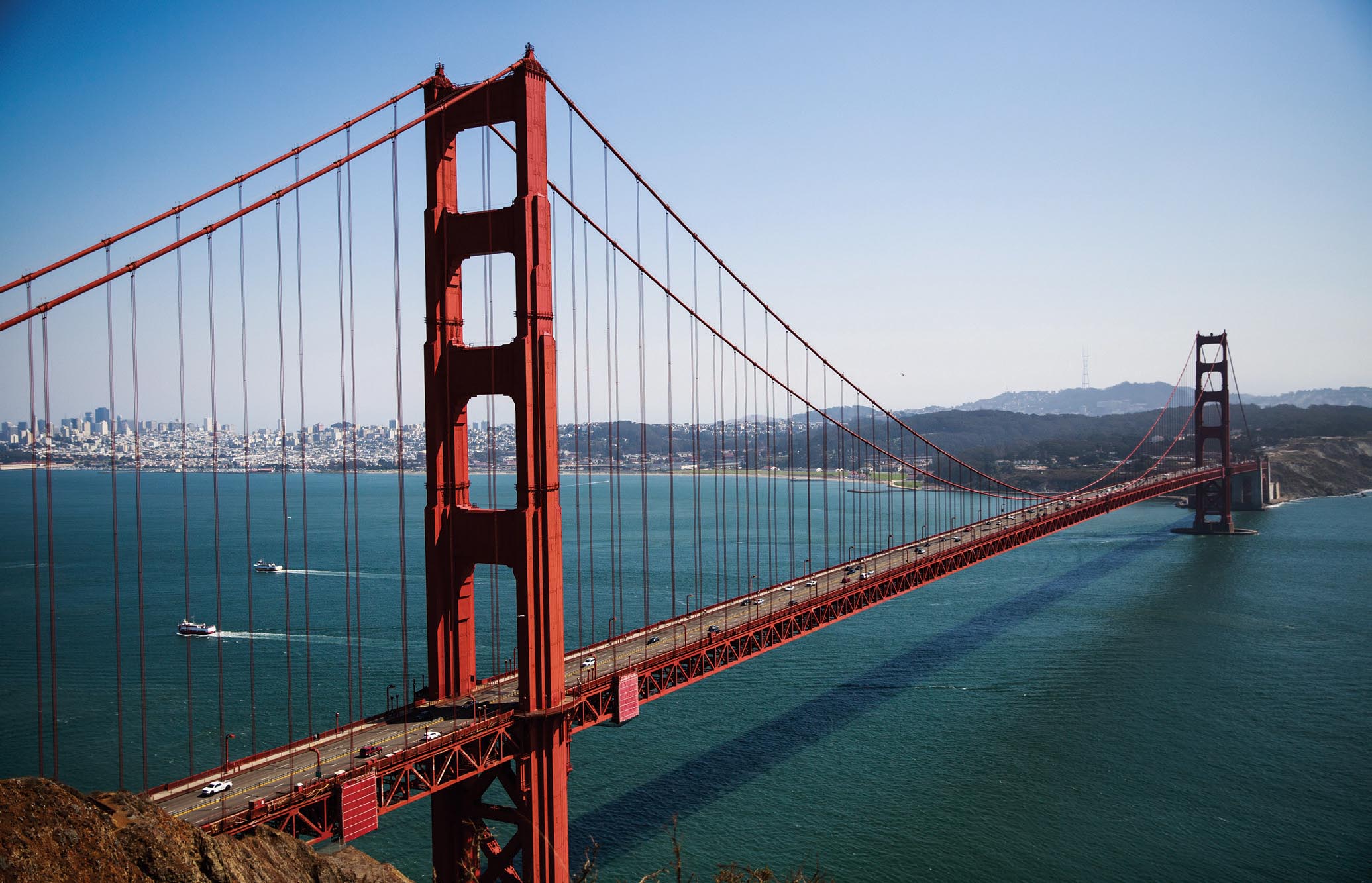
04 Jul WANDERINGS: UNVEILING SAN FRANCISCO
San Francisco has a mood. While certain urban locales have their landmark sites and the right geography and weather, a city’s mood is something less definable, more atmospheric, enigmatic, mysterious, a sensation that hovers.
When I travel to San Francisco, I pause atop any of its many hills, not just to catch my breath from the ascent, but to take in the geometry of the streets as they follow long, undulating lines into the distance, often culminating at the blue, white-capped bay waters. Trolley tracks gleam in the sun, humming as the cables unspool and cars clang in the distance. The rolling fog is a frequent spectacle. The reddish-orange supports and braces of the Golden Gate Bridge, the silver towers of the Oakland Bay Bridge, and Alcatraz Island often come into view, reminding again and again where you are. San Francisco is one of the world’s great cities to explore because it keeps revealing new things. Wander its streets, and you’ll make discoveries.
When I was a boy, instead of hanging pictures of sports stars on my bedroom walls, I affixed, with thumbtacks and tape, pictures of skyscrapers I admired. One was San Francisco’s Transamerica Pyramid, then a new building in 1972. It’s the Eiffel Tower of San Francisco, even more than the Golden Gate Bridge. Its Futurist pyramidal shape rises 48 thrilling stories above the city and remains seemingly omnipresent from every vantage.
Another image on my walls showed the 25-story 1967 Alcoa building (known today as One Maritime Plaza), whose copper-hued facades exhibit exhilarating rhythms of giant Xs, elements that are not only decorative but also play a supporting role in the event of earthquakes. One of the best vantage points for seeing the skyscraper up close, especially when its metallic elements appear to turn molten at dusk, is from Maritime Plaza Park. A staircase leads up from the sidewalk on Clay Street to the plaza. Once atop the street, you enter a calm neighborhood green adorned with Modern sculptures; a nearby pedestrian bridge, from which there are additional city views, links to an apartment and shopping complex.
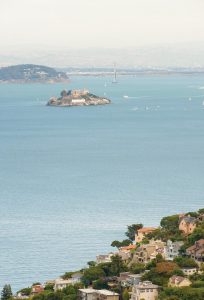
The island of Alcatraz, once a federal prison (it closed as such in 1963), is now managed by the National Park Service. Photo: Visit California/Andreas Hub
Defining features of San Francisco include its many perches and outdoor staircases, places where you rise above the cityscape while remaining amid it. Climb 332 Lyon Street Steps for a bird’s-eye view of the dome of the Palace of Fine Arts and beyond to Marin County. With its eight landings, the steps allow you to pause with each ascent. The steps begin at Vallejo Street and terminate at Broadway and Lyon streets, all within the Pacific Heights neighborhood, one of the city’s loveliest residential areas. While assessing the city from each high vantage, you might have to dodge those using the flights for their workouts.
While cars course a north-south stretch of Highway 101 below, visitors get to walk above the roadway in the aptly named Tunnel Top Park, a 2-year-old, 14-acre public park/art installation/recreation area/engineering marvel in the Presidio (210 Lincoln Blvd.). While Alcatraz and other city vistas remain in view, the park features a variety of public artworks that beckon. Labyrinth, for instance, composed of flagstones and created by Angel Garcia and Brandon Grimaldi, guides you through a series of tightly wound circles until you reach its center. Elsewhere, a seating wall, once just an unadorned cement ledge, has since been transformed with colorful floral-motif mosaics by artist Aileen Barr.
When Michael Polenske, founder of Napa Valley’s Blackbird Vineyards and the owner of four Aerena Galleries in Wine Country, is in his Pacific Heights residence, he often heads to the Presidio, an army outpost turned national park with wooded areas, hills, and scenic vistas overlooking the Golden Gate Bridge, San Francisco Bay, and the Pacific Ocean. He particularly enjoys following the 1,200-foot-long Wood Line by naturalist sculptor Andy Goldsworthy, a work that appears to have grown from the forest floor. Made of reclaimed eucalyptus branches, the land art sculpture meanders through a grove of eucalyptus trees. In time, the wood will age and crumble into the ground, but for now, it cuts a strong, sinuous, alluring pathway through the land.
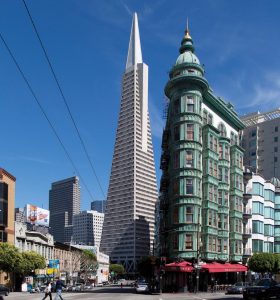
Viewed from the waterfront, the slender 210-foot Coit Tower comes into full view atop Telegraph Hill; it commemorates the city’s firemen, once all volunteers. Photo: Visit California
Every major city has its metaphorical heart, and in San Francisco, it’s Union Square, a vibrant downtown locale with department stores, a café life, clanging cable cars, and a sunny, palm-tree ringed square. While some department stores located near the square have recently closed, the area’s appeal remains evident. Walk down narrow, discreet Maiden Lane to address number 140, and you’ll be able to enter (even shop in) Frank Lloyd Wright’s only building in San Francisco. A classic Wrightian brick archway announces the entrance. Once inside, follow the ramp, a precursor to the walkway in Wright’s Guggenheim Museum in New York. However, instead of art, you’ll be looking at chic men’s clothing from the brand Isaia. This Wright masterpiece was built in 1948, while the Guggenheim was completed in 1959.
For a look at paintings and drawings by working San Francisco artists, wander into CK Contemporary, the flagship gallery of Union Square, if not also of the city. Its owner and founder, Lauren Ellis, will gladly show off works by her stable of some 25 artists — and if you ask for her favorite San Francisco art sites, she’ll tell you about the stained-glass ceiling in the former City of Paris department store (now Neiman-Marcus, 150 Stockton St.) that dates from 1909 and is next door; the Depression-era Works Progress Administration murals she admires every time she climbs Telegraph Hill to Coit Tower; the array of Mark Rothkos and Alexander Calder mobiles she continues to visit at the San Francisco Museum of Modern Art; and the Legion of Honor museum where she can’t resist re-looking at works by Robert Kipniss, the great mezzotint artist of our time (and someone she represents at her gallery). But she also cites a favorite of many visitors and residents, the elaborately sculpted San Francisco Fountain by artist Ruth Asawa outside Union Square’s Grand Hyatt San Francisco (345 Stockton St.). Asawa [1926–2013], the visionary Japanese-American sculptor, fashioned the bronze sculpture in 1970 and it’s ringed with scenes of real and imagined San Francisco landmarks, the depictions for which she created with suggestions from 100 local children.
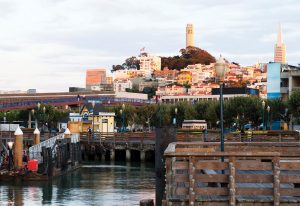
The 1972 Transamerica Pyramid contrasts with buildings
from the early 20th century. Photo: Visit California/Andreas Hub
The American interior designer Suzanne Tucker works near Union Square, too, and as someone with a seasoned eye for design, she often pauses in front of the Hallidie Building (130 Sutter St.). From the street, the 1918 edifice presents itself as an eerily Modern all-glass façade, “juxtaposed with lacy, gold-painted iron ornaments,” as Tucker says. “It remains stunningly beautiful to this day.”
While architect Julia Morgan [1872–1957] designed many buildings in and around the Bay Area, one of her most arresting, and a favorite of Tucker’s, is her 1930 Chinese Historical Society of America structure (965 Clay St.), which was commissioned to be the neighborhood’s first YWCA (Young Women’s Christian Association). Morgan’s decidedly Italian Renaissance edifice also features traditional Chinese arts and crafts detailing, making it one of the West Coast’s most distinctive buildings.
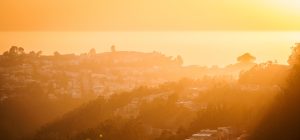
The arrival of the morning fog is part of San Francisco’s signature atmosphere. Photo: Visit California/Max Whittaker
Despite the devastation from San Francisco’s infamous earthquake of 1906, a surprising number of wooden Victorian houses survived, the kind that continue to march their way up and down San Francisco streets. (Though many are technically Edwardian, which came after the Victorian era.) While it’s tempting to look through the windows of private homes to see some of the Victorian detailing within, the Haas-Lilienthal House (2007 Franklin St.) is one such dwelling that you can enter and wander through. The imposing 26-room house, painted a lovely sage green, was built in 1886 and incorporates the best detail and architectural exuberance of the Gilded Age.
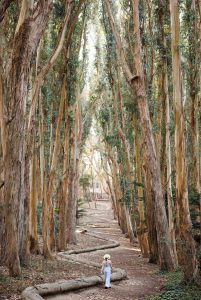
The Presidio is home to four Andy Goldsworthy sculptures, including his 1,200-foot-long Wood Line, completed in 2011 and composed of reclaimed eucalyptus branches, all gathered from the site that was once a U.S. Army base. Feel free to try balancing yourself on the trunks.
Photo: Visit California/Max Whittaker
Part of experiencing a city means looking straight ahead as well as up. On the way to her office at Amazon as the Chief Medical, Production, and Strategy Leader, Dr. Hanh Le can’t resist looking up to the 12 Corporate Goddesses that stand atop 508 California Street. Although artist Muriel Castanis’ 12-foot-high sculptures are faceless and cowled, some passersby regard them as welcoming feminine, if not also feminist, presences, while others find them austere and even macabre.
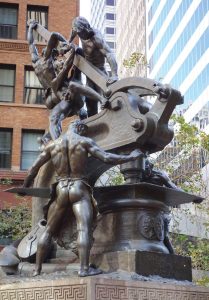
Sculptor Douglas Tilden fashioned the model for his bronze Mechanics Monument in 1899 and saw it dedicated in 1901. It depicts the men who once worked for the city’s Union Iron Works.
And as someone who works in San Francisco’s tech industry for one of the city’s chief employers, Le is also taken with the Mechanics Monument (1901), a depiction of bronze muscled industrial workers at the intersection of Market, Bush, and Battery streets. The sculpture references an era when San Francisco produced hard goods instead of mostly data and information. “It’s beautiful and very much about the antithesis of the workers of today in San Francisco who are mostly tech and financial people, like myself,” says Le. A famous photo of the city post-earthquake shows the sculpture and its figures standing strong.
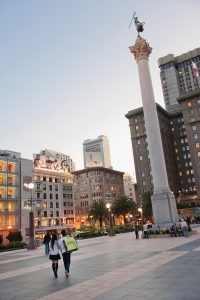
Union Square, which measures 2.6 acres and remains San Francisco’s commercial heart, was named for its role as a rallying point for the Union Army during the Civil War. Photo:
Visit California/Andreas Hub
San Francisco remains a vibrant, complicated, and complex city with many identities that have changed over the ages. As the fog rolls in and out, becoming a kind of natural artwork in itself, the phenomenon also acts as a stage curtain, alternately concealing and revealing a great American city.
David Masello is currently the executive editor of Milieu, a national print magazine about interior design and architecture. Previously, he held editorial staff positions at Town & Country, Country Living, Art & Antiques, Travel & Leisure, Departures, and Avenue magazines. He was also a hardcover nonfiction editor at Simon & Schuster and is the author of three books about art and architecture.
Sidebar:
Dining
A16
415.771.2216; a16pizza.com
Aphotic
415.865.0529; aphoticrestaurant.com
Atelier Crenn
415.440.0460; ateliercrenn.com
Balboa Café
415.921.3944; balbocafesf.com
Boulettes Larder
415.399.1155; bouletteslarder.com
Café Alma
415.336.3286; cafealmasf.com
Daeho Kalbijim & Beef Soup
415.563.1388; daehokalbijjim.com
Garibaldi’s
415.563.8841; garibaldisrestaurant.com
Locali Mediterranean
415.399.9991; localisf.com
Prospect
415.247.7770; prospectsf.com
Quince
415.775.8500; quincerestaurant.com Restaurant Gary Danko
415.749.2060; garydanko.com
Spruce
415.931.5100; sprucesf.com
Taqueria El Farolito
415.824.7877; elfarolitosf.com
Terzo
415.441.3200; terzosf.com
Tosca Café
415.986.9651; toscacafe-sf.com
Yank Sing
415.781.1111; yanksing.com
Accommodations
The Battery
415.230.8000; thebatterysf.com
Fairmont San Francisco
415.772.5000; fairmont-san-francisco.com
Grand Hyatt Hotel
415.398.1234; hyatt.com/grand-hyatt/en-US/sfous-grand-hyatt-san-francisco
Hotel Drisco
415.346.2880; hoteldrisco.com
InterContinental San Francisco,
an IHG Hotel
415.616.6500; icsanfrancisco.com
St. Regis
415.284.4000; marriott.com/st-regis/
san-francisco
Attractions
Alcatraz
CK Contemporary Art Gallery
415.397.0114; ckcontemporary.com
Chinese Historical Society of America
415.391.1188; chsa.org
Coit Tower
415.249.0995; sfrecpark.org
de Young Museum
415.750.3600; famsf.org
Haas-Lilienthal House
415.441.3000; haas-lilienthalhouse.org
Isaia
415.500.4930; isaia.it
Japanese Tea Garden
Legion of Honor
415.750.3600; famsf.org
Minnesota Street Project
415.243.0825; minnesotastreetproject.com Mission Dolores Basilico
415.621.8203; missiondolores.org
Officers’ Club at the Presidio
415.561.4700; presidio.gov
One Maritime Plaza Shopping Center
Palace of Fine Arts
415.608.2220; palaceoffinearts.com
The Presidio
San Francisco Museum of Modern Art
415.357.4000; sfmoma.org
Tunnel Top Park
Vulcan Steps





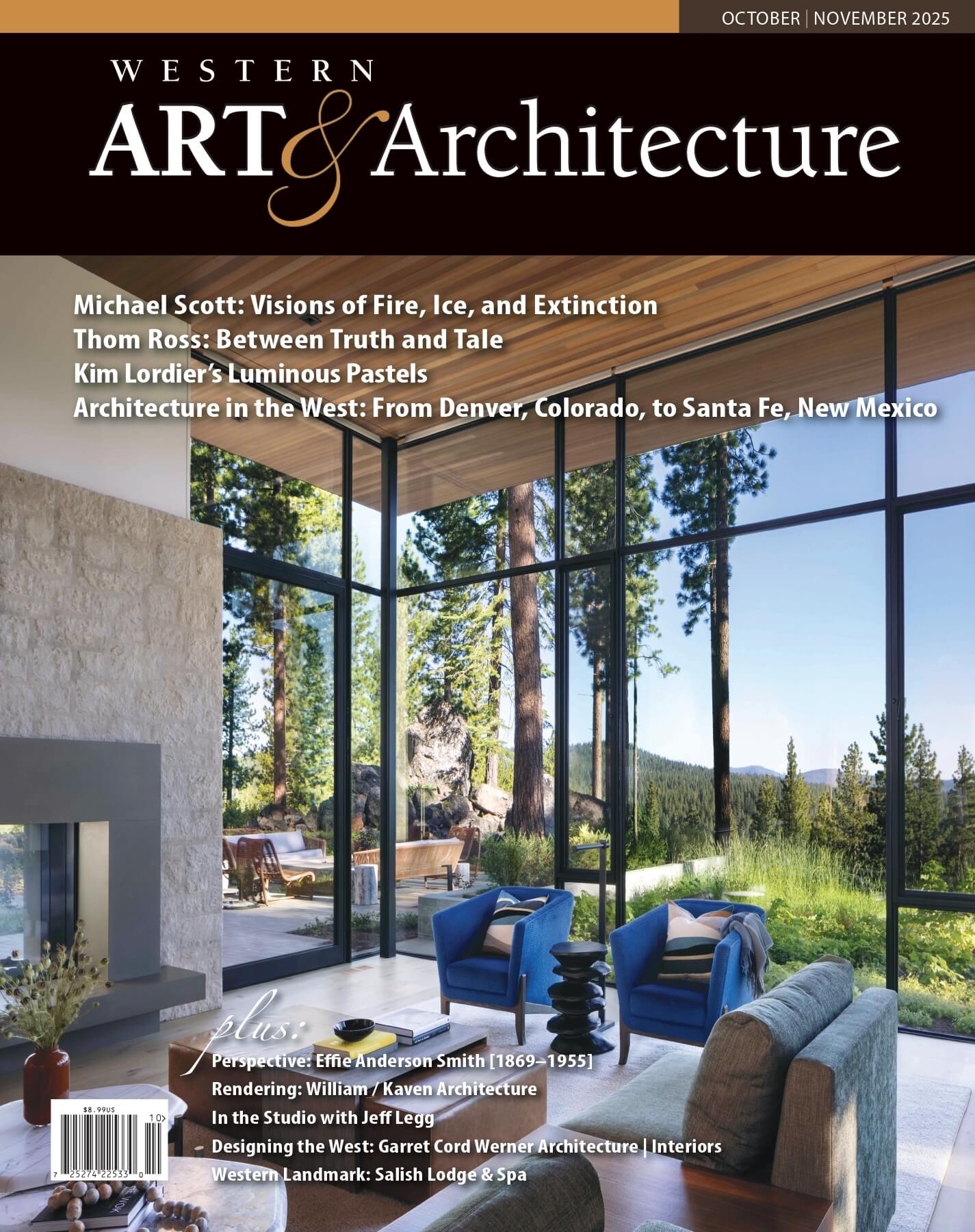
No Comments